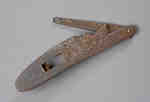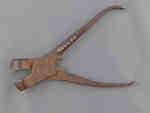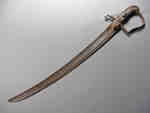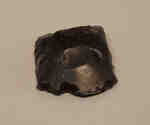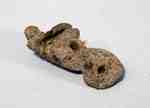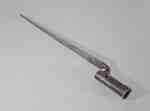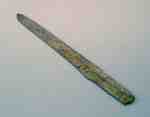Results
- A Brown Bess rifle, commonly called an India Pattern Musket, that has been previously converted from a flintlock to a percussion action. It is a single 39 inch barrel with three ram rod pipes. ThereA Brown Bess rifle, commonly called an India Pattern Musket, that has …
- This is a musket action piece that has ornate markings on one side. This item is currently on display at the Battleground Hotel Museum.This is a musket action piece that has ornate markings on one …
- These are cannon balls from the Battleground Hotel Museum.These are cannon balls from the Battleground Hotel Museum.
- This is a musket ball mold of a plier design. It was used to press a musket ball to the proper size calibre. The press end is hollow and rounded with a hole at one end for pouring in molten metal andThis is a musket ball mold of a plier design. It was …
- These are remnants of a canister shot that is believed to be from one of Niagara’s Battlefields. This form of ammunition, also referred to as a grape shot, was fired at an angle from a cannon and relThese are remnants of a canister shot that is believed to be …
- A sword believed to have been unearthed at one of Niagara’s Battlefields. Inscriptions include “HADLEY” with three circles (near the handle) and “4” with a crown on the blade. The grip of the handleA sword believed to have been unearthed at one of Niagara’s Battlefields. …
- This is a remnant of the tip of a bayonet sheath which can be found at the Battleground Hotel Museum.This is a remnant of the tip of a bayonet sheath which …
- These are various pieces of a musket action that were unearthed at one of Niagara’s Battlefields. These items are on display at the Battleground Hotel Museum.These are various pieces of a musket action that were unearthed at …
- This bar shot was found at the mouth of the Niagara River and is believed to be British. It is two solid cast iron balls connected by a bar to form a shape of a “dumbbell”. Bar shots were cannon weapThis bar shot was found at the mouth of the Niagara River …
- This is a ramrod guide for a British Tower flint-lock musket that was discovered in Niagara.This is a ramrod guide for a British Tower flint-lock musket that …
- An English prismatic type of flintlock that measures 3.7cm x 2.5cm. It belongs to the Servos Collection and was found at Niagara.An English prismatic type of flintlock that measures 3.7cm x 2.5cm. It …
- This bayonet, with a broken tip, would have been designed to fit on the muzzle of a rifle or musket barrel, making it into a close range weapon. There are markings on the bayonet which include: “HarvThis bayonet, with a broken tip, would have been designed to fit …
- This Winchester sword has a steel blade and a leather scooped handle with twined leather.This Winchester sword has a steel blade and a leather scooped handle …
- This is the cock from an India Pattern musket of the British Army. It is oblonged shaped with a narrow bottom and a wide top. The top has a hole through it, as does the left side centre. Below is a pThis is the cock from an India Pattern musket of the British …
- This steel bayonet would have been designed to fit on the muzzle of a rifle or musket barrel, making it into a close range weapon. There are no visible identifying marks but it is the proper size andThis steel bayonet would have been designed to fit on the muzzle …
- This musket, circa 1800, is Brown Bess an “India Pattern” design. The ram rod is missing and there is a make-do front sling swivel. The stock is cracked and the proper right side on the bottom extendThis musket, circa 1800, is Brown Bess an “India Pattern” design. The …
- This bayonet would have been designed to fit on the muzzle of a rifle or musket barrel, making it into a close range weapon. There is a marking on the blade that has a triangular-like symbol with a “This bayonet would have been designed to fit on the muzzle of …
- This is a steel spear point from a Sergeant’s spontoon in the British Army infantry from 1800 to 1820. A spontoon signified a sergeant’s rank.This is a steel spear point from a Sergeant’s spontoon in the …
- This is the tip of a straight bladed metal sword. (missing the handle). It is from a 1796 Infantry officer’s sword.Further research in 2010 suggests that it is a dagger tip with a diamond profile.This is the tip of a straight bladed metal sword. (missing the …
When selecting an individual record or object, you will move
to the website of the heritage institution that houses the item.
To return to the search or results pages, select "Back", "Results" or "New Search".
 This project was made possible with the support of the Department of Canadian Heritage
This project was made possible with the support of the Department of Canadian Heritage
through the Canadian Culture Online Strategy.
to the website of the heritage institution that houses the item.
To return to the search or results pages, select "Back", "Results" or "New Search".
 This project was made possible with the support of the Department of Canadian Heritage
This project was made possible with the support of the Department of Canadian Heritage through the Canadian Culture Online Strategy.








